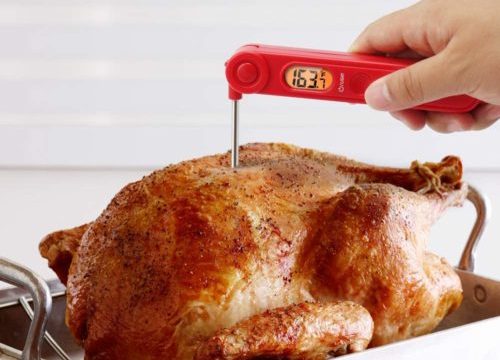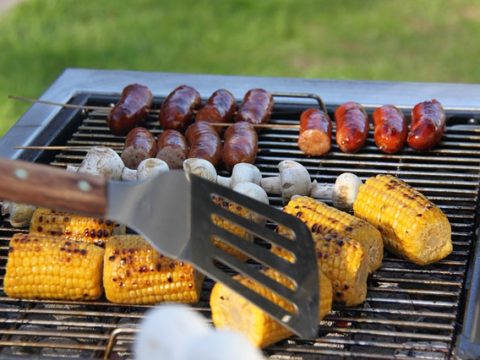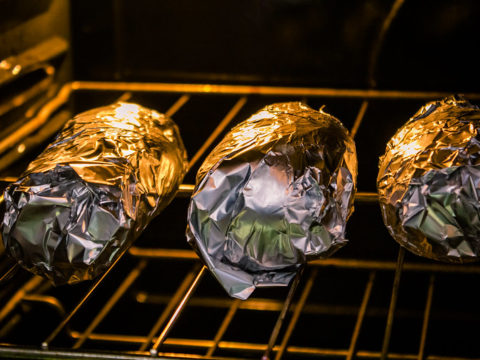
A meat thermometer is used to measure the internal temperature of meats. It can also be used to check the internal temperature for other cooked foods, such as casseroles. The thermometer reading tells when the meat is done and safe to eat. It may also indicates when the meat is cooked to the desired doneness (e.g. rare, medium, well done). When cooking food you should always make sure the interior of the meat reaches a temperature sufficient to kill pathogens (harmful bacteria, viruses and mold) that may cause illness.
All meat thermometers have a metal probe with a sharp point which is pushed into the meat, and a digital or analog display. Some show the temperature only, while others indicate when different kinds of meat are done to the desired finish.
Bi-metal coil thermometers have a needle that rotates showing the temperature on a dial. Another variety commonly used on turkeys is the pop-up timer, which uses a spring held in by a soft material that “pops up” when the meat reaches a set temperature. Bi-metal coil thermometers and pop-up devices are the least reliable types of meat thermometers and should be accompanied by a more accurate digital thermometer.
Other types use an electronic sensor in the probe, connected by a flexible heat-resistant cable to a display. The probe is inserted in the meat, and the cable comes out of the oven and is connected to a display. Oven seals are usually flexible enough to allow this without damage to the seal or significant loss of heat. These types can be set to sound an alarm when the specified temperature is reached. Wireless types, where the display does not have to be close to the oven, are also available.
Single probe thermometers have one probe and monitor one section of the meat only. You need to insert the probe into different places to monitor different parts of the meat. Multi-probe models are avail with 2 or more probes and can accurately monitor the temperature of several locations of the meat.
The probe can be inserted into the meat before starting cooking and remain their until the cooking is finished. An alternative to this is to let the meat cook for a certain time the take it out of the oven and measure the temperature before serving. Be sure to insert the probe in the thickest part of the meat. Do not let the probe touch bone. The bone conducts heat and will gives a higher reading than meat. The meat temperature is what is important and must be accurate.
Safe Minimum Cooking Temperatures
Follow the guidelines below for minimum cooking temperatures and rest time for meat, poultry, seafood, and other cooked foods. Be sure to use a food thermometer to check whether meat has reached a safe internal temperature that is hot enough to kill harmful germs that cause food poisoning.
| Food | Type | Internal Temperature (°F) |
| Ground meat and meat mixtures | Beef, pork, veal, lamb | 160 |
| Turkey, chicken | 165 | |
| Fresh beef, veal, lamb | Steaks, roasts, chops, Rest time: 3 minutes | 145 |
| Poultry | All Poultry (breasts, whole bird, legs, thighs, wings, ground poultry, giblets, and stuffing) | 165 |
| Pork and ham | Fresh pork, including fresh ham, Rest time: 3 minutes | 145 |
| Precooked ham (to reheat), Note: Reheat cooked hams packaged in USDA-inspected plants to 140°F | 165 | |
| Eggs and egg dishes | Eggs | Cook until yolk and white are firm |
| Egg dishes (such as frittata, quiche) | 160 | |
| Leftovers and casseroles | Leftovers and casseroles | 165 |
| Seafood | Fish with fins | 145 or cook until flesh is opaque and separates easily with a fork |
| Shrimp, lobster, crab, and scallops | Cook until flesh is pearly or white, and opaque | |
| Clams, oysters, mussels | Cook until shells open during cooking |
For more information on safe handling and cooking see FoodSafety.gov








